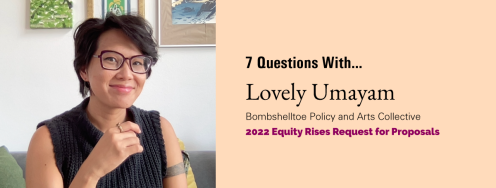By Marissa Conway
I founded the Centre for Feminist Foreign Policy because I kept seeing the same patterns in foreign policy: the exclusion of marginalized communities in policymaking, the pressure on women to bear the burden of peacekeeping and the insistence that gendered ideas (in particular those relying on the threat of violence) were "best" for national security.
Wearing feminist-tinted glasses, I could no longer ignore the disconnect between state action and human consequence.
Perhaps nowhere is this disconnect better exemplified than in nuclear policy. The abstraction of nuclear weapons’ brutally destructive capacity and implicit insistence on certain gendered leadership qualities makes it ripe for a feminist revisioning. The timing could not be better. Every day feminist foreign policy is becoming increasingly mainstream as exemplified by the official adoption of feminist foreign policies by both Canada and Sweden, and now more than ever nuclear weapons are front and center in the American psyche.1 It is time for the United States to adopt a feminist foreign policy. But to do so, it must first re-examine its nuclear policy with a feminist lens.
The policies of the last two US administrations have maintained our position on the nuclear playing field. While the Trump administration inherited plans to spend $1.7 trillion over 30 years to rebuild the nuclear arsenal, its own Nuclear Posture Review added a new nuclear weapon: the low-yield warhead for Trident D5 submarine missiles, designated the W76-2.2 The introduction of and misguided justification for these new weapons have made it clear that now is the time for the United States to look at national security in a fresh and dynamic way.
We must rethink security and consider alternative policies to ensure they break away from outdated and patriarchal structures. This article’s purpose, then, is threefold. First, to define feminist foreign policy. Second, to apply a feminist critique to the justifications in support of the new low-yield warhead. Finally, to outline how the addition of this new warhead undermines the United States’ ability to develop its own feminist foreign policy.
What is a Feminist Foreign Policy?
A feminist foreign policy is both a theoretical approach and a practical framework to ensure policies are truly vested in establishing a more peaceful and equal society. It acknowledges the foreign policy status quo as a flawed structure that reproduces a very narrow and often harmful understanding of security and diplomacy.
At a practical level, a feminist foreign policy means not just including typically marginalized voices in foreign policymaking but also taking them seriously. It involves including those affected by specific policies in consultations, as typically policymakers are not the populations bearing the brunt of their decisions. It asks that budgets are used wisely to reinforce gender equality and anti-racist principles, and money be moved away from militarization and weaponization toward diplomacy and peacebuilding. It means understanding historical contexts and critiquing policy decisions to push for a more just global order.3
In the case of nuclear policy, this process means taking seriously the marginalized voices both at a state- level (for example, non-possessor nations and the Global South) and at a more localized level (for example, women, indigenous people and people of color). It actively seeks to collaborate with a wide range of actors in making policy decisions and grounds its perspective in the risk to human life rather than the abstract strategic benefits of reinforcing deterrence theory. At minimum it freezes current nuclear arsenals and at best eliminates nuclear weapons entirely.
A Feminist Analysis of Low-Yield Nuclear Weapons
Feminist foreign policy puts feminist analysis front and center of its approach. As much as a feminist analysis is about gender equality, it is more broadly a tool to understand power. It insists that nothing occurs in isolation, and understanding the big picture is crucial before analyzing the specific. Most often, it sheds light on who holds the power and why they are unwilling to give it up.
Thus, to understand the low-yield warhead, we must understand the ideas and assumptions that underpin US reliance on nuclear weapons. There are several themes woven throughout US nuclear policy, stemming largely from the Treaty on the Non-Proliferation of Nuclear Weapons. They include a sense of entitlement to nuclear weapons, a belief in the "sanctioned" right to power as granted by treaties and policy and an expectation of being the primary agenda setter for international security. Current US nuclear doctrine is informed by ideas of dominance, competition and strength – gendered characteristics typically coded as masculine. With a feminist analysis these masculinity-driven patterns found in nuclear policy can be unpacked, especially within the proposal for low-yield weapons.
In a June 2018 letter to Senator Mitch McConnell, former Secretary of Defense Jim Mattis detailed the reasons that low-yield warheads on submarines are needed.4 He stated, "The President’s request for the W76-2, a supplemental capability, is in response to developments in Russian nuclear doctrine, exercises and its new nuclear capabilities."5 In other words, as Russian nuclear policy shifts toward potential escalation, then so must ours. This acknowledgement that the low-yield warhead is meant to match Russia boils the issue down to, at least in part, a symbolic battle of superiority between Russia and the United States, both in pursuit of the upper hand in a show of dominance. This reliance on a "dominate or be dominated" mindset (coded as masculine) in nuclear policy fuels the Trump administration’s pursuit of low-yield nuclear weapons and ultimately puts each state’s residents’ lives at risk. Put simply, building the low-yield weapon and allowing nuclear policy to act as an extension of one’s ego is an irresponsible use of power.
The race to the top of the nuclear hierarchy is also reinforced by a reliance on deterrence theory. In his letter, Mattis suggests that "it is not possible to determine precisely what is needed to deter with high confidence. It is, however, possible to get indications that one’s deterrence strategy, posture and capabilities are potentially inadequate."6 He uses this lack of confidence and fear of inadequacy not to knock the zealous worship of deterrence, but rather to encourage modernization so the theory continues to be upheld as law. A feminist analysis is quick to point out that the theoretical "objectivity" of deterrence theory has in fact been manipulated and co-opted as a means to uphold a man-made status quo.
This is reflected in the identification of the low-yield warhead as a more useable, "battlefield-friendly" weapon. The terminology of the new warhead is misleading. Though only a fraction of the size of other atomic weapons in the US arsenal, even a "low-yield" warhead would unleash destruction on the scale of Hiroshima and Nagasaki and kill tens of thousands. And its "usability" is seen as a bargaining chip to deter state-state violence. But, how long can we flex before a bomb is dropped? As Mattis posits, if it’s not possible to say with confidence what ensures nuclear deterrence, then the risk of nuclear warfare is indeed amplified to frightening heights, especially when the key feature of the low-yield warhead is its "usability." If we perceive this weapon as useable, what is to stop its actual use? In fact, in the event of a nuclear exchange, low-yield weapons would be used first precisely due to their lower-yield. Its development does not increase our security. It puts us closer to midnight on the Doomsday Clock.7
Toward a Feminist Foreign Policy
The push for low-yield weapons recycles a realist, power-hungry status quo mindset and is not truly about safety or security. The destructive force and usability of these weapons do not center the human experience over the pursuit of power. Moreover, their development undermines US national security and sets us further down the path to nuclear war. The United States should not build nuclear weapons simply to feel or look powerful or gain an edge over our adversaries, including Russia. Instead, policymakers must develop helpful – not harmful – security mechanisms. As championed by feminist foreign policy, this means building up diplomacy, health care, education, reproductive rights and a sustainable economy.
So, who is setting the current agenda encapsulating us in a new arms race? The defense industry plays a significant role that must be addressed. As Senator Elizabeth Warren highlighted, "We can start by ending the stranglehold of defense contractors on our military policy. It’s clear that the Pentagon is captured by the so-called 'Big Five' defense contractors – and taxpayers are picking up the bill. …The defense industry will inevitably have a seat at the table – but they shouldn’t get to own the table."8 We should be centering the needs of the American public in our policies and with our dollars over the desires of the defense industry.
Furthermore, historically the dominant voice in nuclear policy has been that of white men. Support for the low-yield warhead is championed by a president who espouses traditional gender roles, normative and toxic masculinity, and patriarchal values. The Trump administration is led by a majority of white men, with only three women in senior national security positions. Though simply adding women or people of color into decisionmaking roles and expecting better, more peace-oriented ideas is foolish, their near complete absence in the Trump administration is noteworthy. It reinforces the sheer lack of diverse voices involved in developing policy, particularly national security and nuclear policies.
These weapons inherently sit at odds with a feminist foreign policy. Ultimately, to ensure true national security, the values a feminist foreign policy espouses – a diversity of voices, grounding policy in the human experience and moving money away from militarization and toward more holistic understandings of security – must be prioritized. So, what can be done?
- Conduct oversight. Congress has a duty of oversight, and the American public deserves to know the truth about low-yield weapons and to hold accountable those justifying their development. Congress should exercise its duty and hold hearings on the low-yield warhead.
- Cancel the low-yield warhead. In fall 2018, Representatives Ted Lieu (D-CA) and Adam Smith (D-WA) introduced the Hold the LYNE Bill which would "prohibit the research, development, production and deployment of low-yield nuclear warheads for submarine-launched ballistic missiles."9 Members of Congress can support this bill and others that move money away from the low-yield warhead.
- Include more marginalized voices in nuclear policymaking. Expanding the base of nuclear and national security leadership to include those with different life experiences is of the utmost importance. The broader the knowledge that feeds policy, the better chance there is of implementing effective security and foreign policies that do not uphold traditionally idealized masculine traits of dominance and power.
- Rethink security. It is critical to rebuild ideas of security as ones that are not reliant on violence. Peaceful coexistence understands that education, access to reproductive health care and societal equality are far greater indicators of the stability of a nation than any amount of weaponry ever has been. When national security incorporates these issues into its strategy rather than solely focusing on power optimization, disarmament can become politically palatable and a peaceful, nuclear-free world a more likely reality.
Conclusion
Whether or not one personally ascribes to feminist principles, a feminist foreign policy is a powerful framework to flip any issue on its head and peel back the layers of power to reveal the hidden truths beneath. When it comes to nuclear policy, understanding the context, the power dynamics and the truths behind public justifications is critical.
The Centre for Feminist Foreign Policy was founded not solely for those already sympathetic to a feminist agenda, but to bring everyone on a journey to push the boundaries of foreign policy and encourage a more people- oriented policymaking process. When discussing nuclear weapons, the human experience must be at the center. Every policy option must be explored, as many diverse perspectives as available included and every justification rooted in true security – not a drive for power or money. Ultimately, to build a more equal and peace-oriented society, a feminist foreign policy must be adopted and low-yield nuclear weapons abandoned.
Marissa Conway is the co-founder and UK director of the Centre for Feminist Foreign Policy, a research and advocacy organization promoting people- centered policy. Follow her at @marissakconway.
This article is part of our new report, "A New Vision: Gender. Justice. National Security." See all the articles from our report here.
It is long past time for the US to adopt a #feminist nuclear policy #NewVision2019.
1 Nathalie Rothschild. “Four years on, Sweden remains committed to its feminist foreign policy,” OpenCanada, (Centre for International Governance Innovation) (Centre for International Governance Innovation), Mar. 5, 2018, https://www.opencanada.org/features/four-years-sweden-remains-committed-its-feminist-foreign-policy/; Karen K. Ho. “Canada puts its feminist foreign policy to the test,” OpenCanada, (Centre for International Governance Innovation) (Centre for International Governance Innovation), Mar. 6, 2018, https://www.opencanada.org/features/canada-puts-its-feminist-foreign-policy-test/.
2 Congress approved $65 million toward its development in September 2018; US Department of Defense, Office of the Secretary of Defense, Nuclear Posture Review, (Washington, D.C., 2018), https://fas.org/wp-content/uploads/media/2018-Nuclear-Posture-Review-Version-2.pdf; Joe Gould. “Democrats trying to ban low-yield nuclear warhead,” Defense News, Sept. 20, 2018, https://www.defensenews.com/congress/2018/09/20/democrats-trying-to-ban-low-yield-nuclear-warhead/.
3 “Feminist Foreign Policy,” Centre for Feminist Foreign Policy, accessed December 19, 2018, https://centreforfeministforeignpolicy.org/feminist-foreign-policy/.
4 “Read Mattis’s letter defending the new low-yield warhead,” Washington Post, 2018, https://apps.washingtonpost.com/g/documents/national/read-mattiss-letter-defending-the-new-low-yield-warhead/3021/.
5 US Department of Defense, Office of the Secretary of Defense, Letter to Senator Mitch McConnell, by Secretary James Mattis, Jun. 3, 2018, https://www.documentcloud.org/documents/4505370-Read-Mattis-letter-defending-the-new-low-yield.html.
6 “Read Mattis’s letter defending the new low-yield warhead,” Washington Post, 2018, https://apps.washingtonpost.com/g/documents/national/read-mattiss-letter-defending-the-new-low-yield-warhead/3021/.
7 “Doomsday Clock,” Bulletin of the Atomic Scientists, accessed December 7, 2018, https://thebulletin.org/doomsday-clock/.
8 Nik DeCosta-Klipa. “Read the transcript of Elizabeth Warren’s big foreign policy speech,” Boston.com, Nov. 29, 2018, https://www.boston.com/news/politics/2018/11/29/elizabeth-warren-foreign-policy-speech-american-university.
9 Joe Gould. “Democrats trying to ban low-yield nuclear warhead,” Defense News, Sept. 20, 2018, https://www.defensenews.com/congress/2018/09/20/democrats-trying-to-ban-low-yield-nuclear-warhead/.
Photo: TM-61 Matador Cruise Missile at the National Museum of Nuclear Science & History, Albuquerque, NM. Image: Smriti Keshari.




